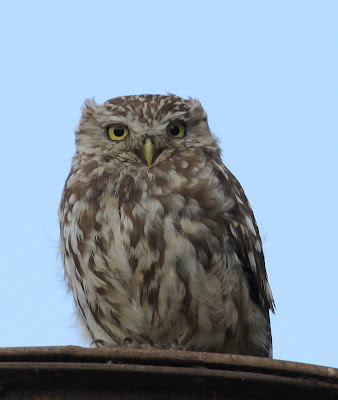Andy and I were due to go ringing this morning but then he cried off because of an emergency baby-sitting request. Grandparents come in useful sometimes, even if the old fools do vote the “wrong” way in referendums and generally don’t do as they are told.
Not to worry, I decided to go birding instead of ringing. I was at the car putting on a jacket when I heard a Tawny Owl hooting from nearby gardens, a reminder of autumn and that today is the first day of September.
The main times to hear Tawny Owls call is during the breeding season which runs from February/March to May, and then again in the autumn when the adults have finished their moult. In June and July the adults tend to go silent and only the young may be heard, squeaking for food throughout the night from dusk. August, September and October can be very active times vocally for adults as they set about reaffirming their territories in preparation for the next breeding season.
Tawny Owl
As usual I drove over the moss road towards Pilling. It’s a more productive bird route than the main road although in the half light of this morning the best I managed was a Kestrel on the usual roadside post. Near Pilling village I saw a Barn Owl on a fence post so slowed the car in preparation for a possible photographic encounter. Not this time. The owl was away and across the fields before I could even lift the camera.
I made for the flood at Out Rawcliffe where on Saturday 27th August I’d seen the Marsh Harrier and a few waders. Today was also the first day of the inland shooting season, something I remembered when from across the fields I heard the sound of gunfire but saw no people carrying shotguns.
The parish of Out Rawcliffe is one of the largest in England. It takes more than a couple of hours to walk north to south or east to west over the mossland, so I wasn’t too worried that the guns would be on me soon; there was time to scope the flood for birdlife.
Out Rawcliffe, Lancashire
On the water I counted the wildfowl as 150+ Mallards and 24 Teal. So many Mallards indicated the recent release of captive-bred birds and another reason for the sound of gunfire. By contrast the Teal are truly wild birds and recent arrivals from north and east. Waders today comprised just the two species, 220 Lapwing and 4 Black-tailed Godwits.
Lapwings
There was a single Kestrel about plus 3 or 4 Buzzards, and then as a bonus 2 Marsh Harriers in the air together over the trees and the distant water. There was some interaction between the two harriers when I could see that both were “cream tops”, juvenile/female types with noticeable and extensive creamy foreheads. Local Swallows instinctively mobbed the pair of raptors but I can’t imagine the circling harriers were any real threat to the Swallows.
Marsh Harrier and Swallows
Soon a line of a dozen or more sportsmen appeared on the horizon, spread right to left at regular intervals over the maize field dotted with blue feeder bins that sate the released partridge and pheasant. The shooters were headed slowly towards the flood so it was time for me to head in the direction of Conder Green.
In the wildfowl stakes I counted 19 Little Grebe, 5 Shoveler and 3 Wigeon on the pool, 4 Goosander in the main creek and 20+ Teal in all. Just 3 Little Egret today but a zero count of Grey Herons and a species that continues to disappoint in the numbers seen at expected and traditional locations.
Waders obliged with 105 Lapwing, 24 Redshank, 3 Greenshank, 3 Snipe and 1 Common Sandpiper. A Kingfisher put in the usual fly-by appearance as did a passing Kestrel.
Over near the railway bridge the nesting House Martins numbered 20+, a similar quantity to the Swallows hanging around the nearby farm buildings. Otherwise - 15 Linnet, 2 Pied Wagtail, 1 Reed Bunting.
House Martin
I was saddened today to hear of the passing of a fellow blogger and ringing pal Lew/Errol Newman, a name that blog readers will know from reading the “Under Rydon Hill” link in the right hand sidebar.
Like me Lew was a regular visitor to Bardsey Island, Wales where our paths sometimes crossed. Lew almost singlehandedly built the main Heligoland trap in the central withy beds. It was a trap that worked like as dream and I had cause to thank Lew on a number of occasions when his construction presented me with bags full of birds and several ringing “ticks”. Lew will be greatly missed by friends, colleagues, family and his partner Jenny.
Linking today to Anni's Birding and Eileen's Blogspot.
Like me Lew was a regular visitor to Bardsey Island, Wales where our paths sometimes crossed. Lew almost singlehandedly built the main Heligoland trap in the central withy beds. It was a trap that worked like as dream and I had cause to thank Lew on a number of occasions when his construction presented me with bags full of birds and several ringing “ticks”. Lew will be greatly missed by friends, colleagues, family and his partner Jenny.
Linking today to Anni's Birding and Eileen's Blogspot.






























































